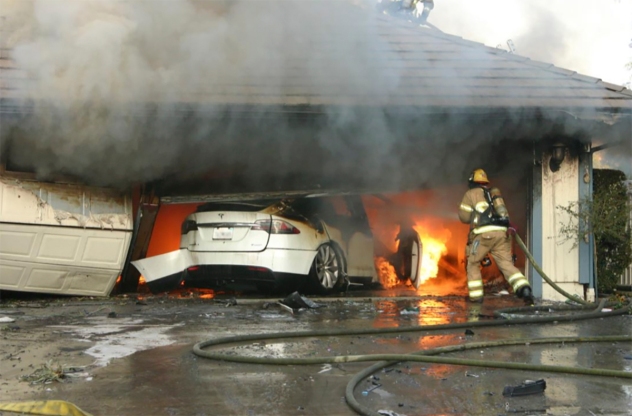
Electric Vehicles Catch Aflame During Ian Aftermath

An impending revolution in the automobile market has come across quite the snag during the aftermath of Hurricane Ian.
In Florida, electric vehicles have become an increasingly popular pick for residents, with over 95,000 registered in the state at the end of 2021. However, in the wake of the Category 4 hurricane that hit the state last month, these vehicles have been more akin to a time bomb.
Saltwater flooding in the state’s coastal areas caused the lithium ion batteries in electric vehicles to combust, catching fire. Firefighters near Naples had to put out six blazes related to the vehicles in the days following Ian’s landfall.
Eric Wachsman, director of Maryland’s Energy Institute, stated that the qualities of lithium ion battery cells that allow them to move a passenger vehicle also make these cells vulnerable to ignition, due to the cells having closely placed electrodes that are filled with a flammable liquid electrolyte.
“This flammable liquid could get into what’s called a thermal runaway situation where it just starts sort of boiling, and that results in a fire,” he told CNBC in January.

Florida’s chief financial officer and state fire marshal, Jimmy Patronis, wrote on Twitter that “as those batteries corrode, fires start,” giving a “new challenge” to Florida firefighters. Patronis also asked Jack Danielson, executive director of the National Highway Traffic Safety Administration, for “immediate guidance” on the issue.
“In my experience, Southwest Florida has a significant number of (electric vehicles) in use, and if those (vehicles) were left behind, exposed to storm surge, and sitting in garages, there is a risk of fires,” Patronis wrote.
Responding to Patronis, Danielson wrote that firefighters and other first responders “not involved in immediate lifesaving missions” should identify flooded electric vehicles with lithium-ion batteries and move them “at least 50 feet ” away from other structures, vehicles and combustibles, in order to eliminate any possible collateral damage from electric vehicle combustion.
“Test results specific to saltwater submersion show that salt bridges can form within the battery back and provide a path for short circuit and self-heating,” Danielson wrote. “This can lead to fire ignition. As with other forms of battery degradation, the time period for this transition from self-heating to fire ignition can vary greatly.”
According to a study by AutoinsuranceEZ, battery electric vehicles have a .03% chance of igniting, while internal combustion engines of non-electric vehicles have a 1.5% chance. On top of that, electric vehicle fires require more water to extinguish flames, according to Emma Sutcliffe, project director of EV FireSafe in Melbourne, Australia.

Sutcliffe noted that electric vehicle batteries can also re-ignite hours, or perhaps days, after the fire is initially controlled.
“A lot of the time, firefighters and fire agencies are just expected to kind of figure it out,” Sutcliffe told CNBC.
Patronis echoed this sentiment, stating that much of the guidance he has received on the topic of submerged vehicles “does not address specific risks associated with exposure of (electric vehicles) to salt water.”
“[I] saw with my own eyes an [electric vehicle] continuously reignite, as fire teams doused the vehicle with tens of thousands of gallons of water,” Patronis said.
Sen. Rick Scott, R-Fla., addressed a letter to U.S. Transportation Secretary Pete Buttigieg, D, about the topic, highlighting the harm that can be done by electric vehicle ignition, including the loss of some homes in the aftermath of Ian.
“This emerging threat has forced local fire departments to divert resources away from hurricane recovery to control and contain these dangerous fires,” Scott wrote to Buttigieg, claiming that these fires can take more than six hours to burn out, and adding, “Alarmingly, even after the car fires have been extinguished, they can reignite in an instant.”

Supporters of the electric vehicle industry have pushed back on the words of Scott, including Joe Britton, executive director of the Zero Emission Transportation Association. Britton said that Scott’s statements about the safety of electric vehicles were “misleading.”
Vilas Pol, a professor of chemical engineering at Purdue University, said that lead-acid batteries found in both electric and gas vehicles can also catch fire via saltwater submersion, much like lithium-ion batteries. However, Pol also noted that the risk of those fires reigniting is smaller than fires from lithium-ion batteries.
Produced in association with AccuWeather.
The Western Journal has not reviewed this story prior to publication. Therefore, it may not meet our normal editorial standards. It is provided to our readers as a service from The Western Journal.
Truth and Accuracy
We are committed to truth and accuracy in all of our journalism. Read our editorial standards.
Advertise with The Western Journal and reach millions of highly engaged readers, while supporting our work. Advertise Today.










